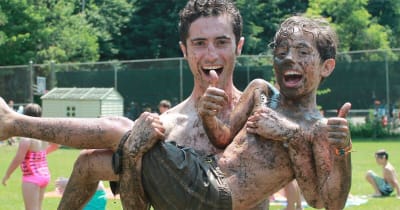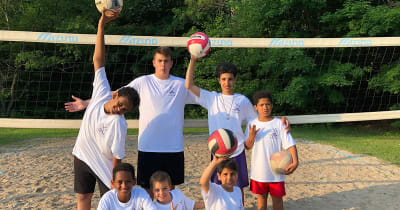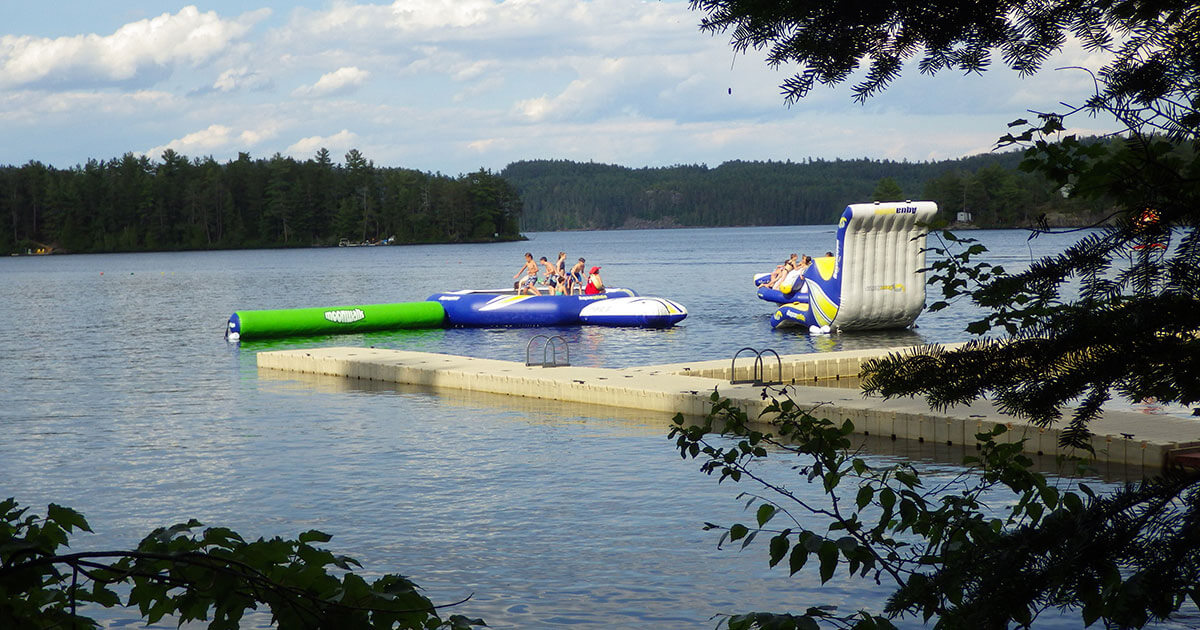Talk to the director
“If you’re a camp director, safety must be your number one priority,” says Ross. So, after examining the camp’s website, which will likely address most safety concerns, have a conversation with the director.
“I not only encourage parents to call us before they register for camp, but also throughout the summer if they have concerns,” says Patti Thom, director of Camp Tanamakoon in Algonquin Park. This residential camp—like most of its kind—has strict policies around issues such as food cleanliness and safety, allergies and dietary needs, water purification, camper health and wellness, medical services, staff-to-camper ratios, and waterfront, wilderness, and program safety; all of which the director is happy to discuss in detail.
Rates of injury through camp are significantly lower than those of most organized sports: study
When asked about safety, Sol Birenbaum, director of Camp Walden, likes to tell parents, “kids have been swimming in the lake at Camp Walden for decades, and the same safety standards that have always been in place, continue to be in place (i.e. the buddy system and lifeguard training). But, like all things, safety precautions continue to evolve each summer. And, any concern that’s top of mind for parents is also top of mind for camp directors.”
Addressing everything from physical safety to emotional well-being, a good director is committed to ensuring each child has a positive camp experience. “These days the focus is on anxiety and nervousness,” says Birenbaum. Open communication is the best solution, and it starts by letting parents and campers know exactly what to expect. “In the past, an info night at a library would be enough; nowadays I spend my time visiting families’ homes. I gladly do this, knowing it will help everyone feel more comfortable come summer,” he says.
Ask about formal safety accreditations
Many camps have formal safety accreditations granted by provincial camp associations. Each provincial association has standards, outlined in detail online, that member camps must adhere to.
These standards often go above and beyond what is required by law.
An overall camper-to-staffer ratio of at least 8:1 is mandatory for Ontario Camp Association accredited camps, (which might make camp one of the most heavily-supervised kids activities out there).
An overall camper-to-staffer ratio of at least 8:1 is mandatory for Ontario Camp Association accredited camps, (which might make camp one of the most heavily-supervised kids activities out there).
You can see a camp's accreditation by visiting their OurKids.net profile (find camps here) or by visiting their website.
Just because a camp hasn't sought accreditation, however, doesn't mean they aren't safe. Joining a provincial association involves more than abiding by their safety standards. It is, nonetheless, worth asking these camps why they aren't accredited, and paying closer attention to their safety measures.
Ask about counsellor training
“The main concerns we get from parents are how we train our counsellors and what type of background checks we do,” says Thom. For her, the answer is simple: “Ninety per cent of our staff grew up with us as campers; they’ve been here since they were kids, and we’ve trained them as leaders.”
Camp staff are usually well-trained and knowledgeable, Ross says. Requirements for qualifications will vary according to the staff member’s role, location and program. The waterfront director, for example, requires National Lifeguard Service (NLS) certification. Trip leaders in situations where boating or swimming is involved require Bronze Cross, standard first aid and CPR. First aid and CPR are part of pre-camp training in many camps. Though it’s not mandatory for all camps unless required by legislation or an accreditation group, many camps do a criminal record check for each new staff member.
"When our kids take part in canoeing, kayaking, rock climbing or mountain rappelling, they’re supervised by staff who are certified in those areas," adds Gordon Hay, director of Venture Academy in Kelowna, B.C., which runs a camp for troubled teens.
Ask about access to medical attention
Next, find out whether the camp you’re sending your child to has a doctor and/or nurse on-site. “These days we have more kids visiting our med lodge and more kids on medication, so we’ve responded by upping our medical staff,” says Joanne Kates, Director of Camp Arowhon. At any given time, Arowhon has three RNs and one MD on-site.
Have faith
Once your concerns have been addressed, Birenbaum says, “it’s time to trust your decision.” Parents can rest assured knowing a good camp’s number one priority is your child’s safety.
“From a research perspective, I can tell you that a US national study conducted at camps between 2006 and 2010 showed that rates of injury through camp experience were significantly lower than those of most organized sports,” says Stephen Fine, PhD, director of Hollows Camp and chair of the National Research Committee of the Canadian Camping Association. “From a personal perspective, as a camp director with 30 years’ experience in Canada, I can attest to the same.”
As technology makes it possible for parents to be in constant communication with their children, sending them to camp where they’re not reachable can cause discomfort. Concern for a child's saftey is wholly justified, but it can also undermine (or slow) a child's normal development if left unchecked, (see our coverage of kidsickness for more).
Case Study: A past director discusses safety measures taken at camp
The following is written by Catherine Ross, past camp director.
Safety starts with the site.
The local medical officer of health visits the camp site regularly to ensure that all health and safety regulations are met.
Buildings, erected according to building and fire codes, must be weatherproof, properly screened and equipped with smoke detectors, fire fighting equipment and carbon monoxide detectors where specified.
Camp directors or their designates tour the property regularly to ensure that all buildings, equipment and systems (water, electrical and mechanical) are well maintained. Only authorized personnel are allowed on the property. In some camps, this means that a staff person is on watch throughout the night.
At the beginning of the season, the entire site, indoors and out, is closely inspected.
At the beginning of the season, the entire site, indoors and out, is closely inspected and necessary repairs made. Docks are checked for loose boards or raised nails. Every element on the high ropes course is thoroughly scrutinized. Unsafe trees are felled.
Shorelines are scoured for debris washed up over the winter. Some areas are designated out of bounds for campers, for example: parking areas, pump houses, workshops or the kitchen. Docks are off limits unless accompanied by a counsellor.
In pre-camp, arrangements are confirmed with the local health care facility, ambulance, fire and police departments in the event that their support is needed.
In pre-camp, arrangements are confirmed with the local health care facility, ambulance, fire and police departments in the event that their support is needed.
Emergency services are provided with maps and directions to the camp site so that if summoned, they arrive quickly. Contact numbers for local emergency services are posted next to the camp phones. Campers are safe and secure because directors carefully plan for the expected and the unexpected.
Safety is ensured by a well trained, knowledgeable staff.
At camping conferences, camp directors learn the principles of risk and crisis management. They assess the risks associated with their own camp and develop plans to eliminate or minimize those risks.
Where there is a body of water on the site, whether it is a pond, river, lake or ocean, strict rules are enforced by the Waterfront Director who oversees the staff and operation of all activities in the entire waterfront area.
No one is allowed in the swim area until the lifeguards are on duty. During recreational swims, campers swim with and watch out for their buddy in addition to being supervised by lifeguards. Spotters on shore with access to emergency rescue craft are assigned to watch sailboats or sailboards.
Counsellors accompany campers in canoes or kayaks. On the water or in wide open spaces, counsellors teach campers how to protect themselves from the sun with hats, sunscreen, sunglasses and proper clothing. They encourage their campers to seek shade and drink lots of water.
Camps located in a forest teach campers to stay in populated areas. On trips away from the main site, campers are always accompanied by a counsellor.
Constantly, directors tour their site supervising the staff and overseeing all aspects of their operation. They write comprehensive policies and procedures then train their staff in their implementation. In turn, the counsellors teach their campers to be safe.
Constantly, directors tour their site supervising the staff and overseeing all aspects of their operation. They write comprehensive policies and procedures then train their staff in their implementation. In turn, the counsellors teach their campers to be safe.
Former campers who are familiar with the rules and procedures also help to educate new campers. Upon arrival, campers learn the most important safety rules, which they are expected to obey without question - rules such as: no swimming without permission, no boating without permission or no walking alone in the woods. Over the next few days, as they participate in each new activity, they gradually learn and use the safety rules, which are posted and carefully explained.
Fire and emergency drills are practised early in each session. I recall a Brownie and Guide Area Weekend Camp when the senior leader in charge forgot to do a fire drill. Although on that first Friday night, it had taken us several hours to settle the large, excited group, at midnight, she insisted on waking everyone to do the required fire drill. Safety superseded sleep!
Counsellors are certified in first aid, water safety and cardio-pulmonary-resuscitation (CPR). They are observant and alert. They are the first to put on a lifejacket, closed-toe shoes or a safety helmet and harness to set the proper example for their campers to emulate.







